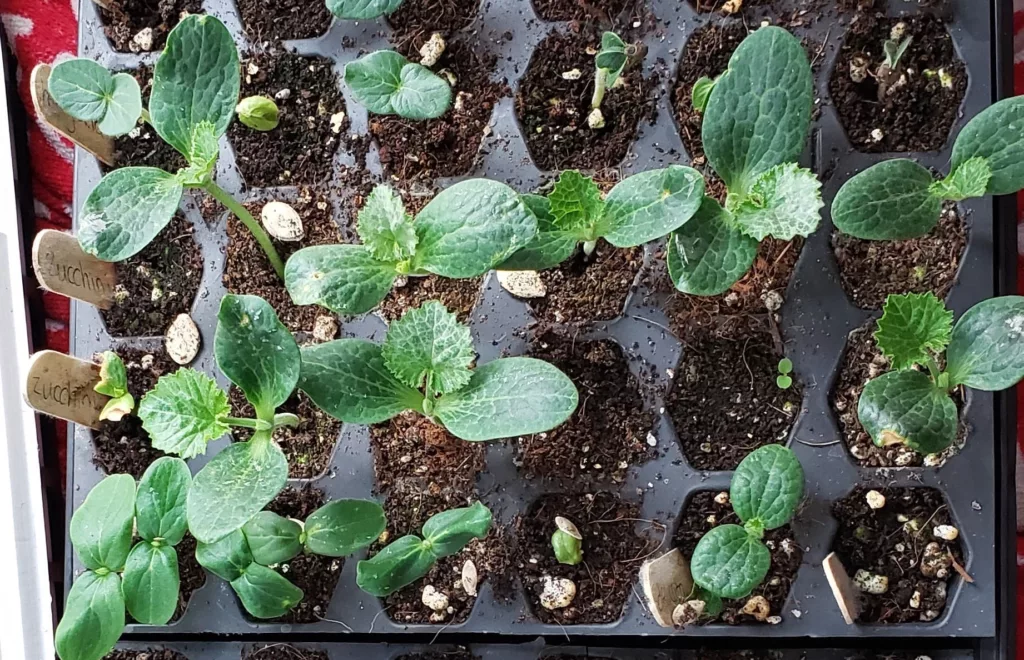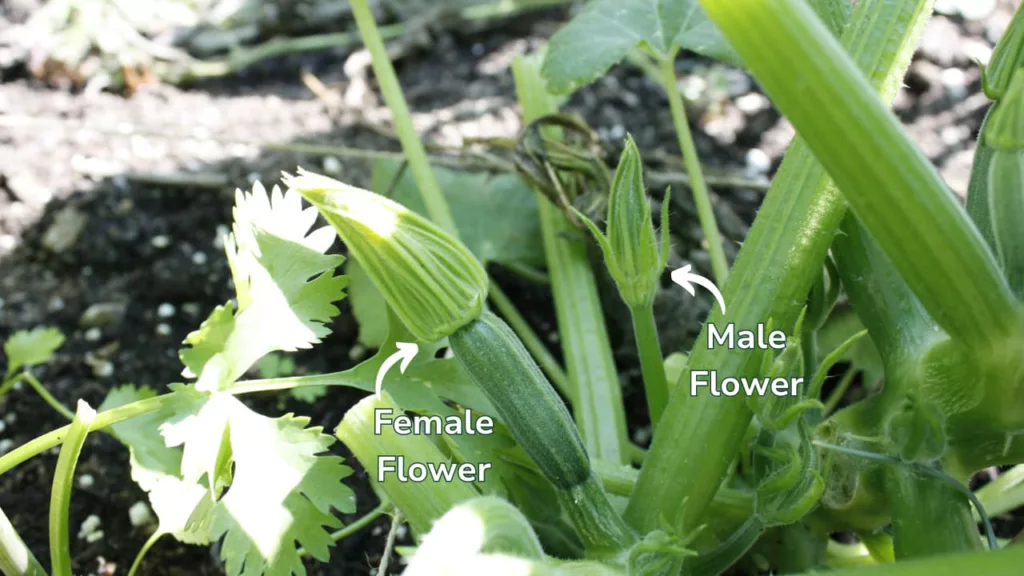Zucchini is one of the easiest plants to grow from seed. They produce a lot of fruit and are a garden staple. These plants grow large and take up a lot of space in the garden, but make up for it in production.
A Quick Summary
Zucchini is a vegetable in the cucurbita family, often called summer squash that has a quick days to harvest, anywhere from 35-55 days. They love full sun, require pollinators to make fruit, and are great for beginners. Zucchini is susceptible to some fungal and bacterial issues, and is the target of the squash vine borer. Overall, it’s a great plant to include in your garden.
Zucchini Varieties

There are quite a few different varieties of zucchini available. There is the classic green zucchini, a yellow variety, light green and even ribbed fruits. They also have zucchini that grow in small ball shapes.
The yellow zucchini varieties tend to grow thicker skins in comparison to the green varieties, so they are best picked smaller. We recommend the Yellowfin Organic variety to grow.
One of the most common varieties is Black Beauty, and another popular variety is Romanesco.
Sun and Soil Requirements
Zucchini plants prefer full sun (6+ hours), and want fertile soil. Ensure you water your zucchini plant regularly and fertilize it if your soil was not topped up with organic matter in the spring.
Join the newsletter to get more great advice straight to your inbox!
How to Plant Zucchini Seeds

Zucchini plants are simple to grow from seed. The seeds are large making it a great plant for beginners and planting with children. The seeds germinate quickly, and the seedlings will grow at a fast rate. Be prepared to pot them up in a larger pot regularly, and don’t start them too soon. Start zucchini indoors 4-5 weeks before last frost.
Caring for Zucchini Seedlings
Zucchinis are a hungry plant, so it’s important to plant them into nutritious soil. Once the seedlings have grown their first true leaf, move them from the seed starting soil into a potting soil with nutrients. Be watchful of the plants to make sure they don’t outgrow their pots and upgrade them when required. Water the seedlings from below to help promote roots growing downward, building a strong root ball.
Continue your garden learning:
- How to Control Squash Vine Borers
- How to Grow Zucchini from Seed to Harvest
- How to Protect Your Plants from Cucumber Beetles
- How to Grow Cucumbers From Seed to Harvest
- What the Calgary Water Main Break Can Teach Us In Our Gardens
Planting Guide
Zucchini takes up a lot of space in the garden. Make sure that you plant in a location that allows it to grow to full size without growing overtop of other plants. When first planting out the seedlings, make sure to remove any flowers to allow the plant to focus on root growth. Give it a good water once it’s been planted.
If you want to grow your zucchini vertically, add a pole beside the plant and start tying it up as it begins to grow.
Watering
Zucchini prefers regular waterings to grow. Make sure to give it a good, deep water at the roots every few days.
Maintenance

If your zucchini is growing large and taking over your garden, you can prune the leaves off of your plant as required. This allows for good airflow while preventing the plant from taking over your garden.
In terms of growing fruit, zucchinis have both male and female flowers, and it’s required for a male flower to be open at the same time as a female flower to successfully pollinate.
If you are growing multiple plants and one plant has a male flower, while the other has a female flower open, they can be pollinated across plants. If you are concerned about the pollinators not finding the flowers, you can hand pollinate. To do this, the first thing is to make sure the male flower has fully developed and has pollen on it. Then, pick the male flower off the plant, peel the petals off of it to leave just the centre of the flower (the stamen) and rub that on the inside of the female flower. This guarantees that your female flower has been pollinated, and you will be harvesting zucchini not long after!
Harvesting
Zucchini fruit grows really quickly. Zucchini tastes best when they are small and tender, but you can wait until they get to 30cm and harvest them. If you wait for the squash to get larger, the skin will be thicker and the flesh will resemble more of a winter squash. The more frequently you harvest, the more the plant will produce.
Ways to Enjoy Zucchini
Zucchini is incredibly versatile! There are so many ways you can cook zucchini, or even bake it. Here are a few different ways to enjoy zucchini: fried with other vegetables, fritters, fried zucchini flowers, zucchini bread, and even as pickles!
Join the family, get advice straight to your inbox!
Common Pests & Problems
Powdery Mildew



Powdery mildew is a fungal disease that often affects zucchini plants later in the season. If you notice your plants start getting a white, powdery look on your leaves, prune those leaves off and dispose of them. Make sure you clean your pruners before using it on any other plants. Good air circulation and sunlight can help slow it down.
Squash Vine Borer

The squash vine borer is the biggest nemesis of the zucchini. I don’t think we’ve gone a single year without getting vine borers on our plants. The squash vine borer is a daytime flying moth that lays eggs on the base of its host plants. These eggs hatch and the larvae burrow into the stem and eat their way back out. Once your plant gets vine borers in it, its fate is sealed and your plant will die. Planting a second round of squash later in the season allows you to get zucchini from the new plant if the first one dies.
Saving Zucchini Seeds
You can save seeds from zucchini plants, however be careful about what variety you are growing as a lot of seeds on the market are hybrids and you can’t save seeds from them. If you do choose to save seeds from your zucchini, make sure that it wasn’t planted too close to other types of squash as they can cross pollinate.
When saving seeds, allow the fruit on the plant to grow to full size (which will be big!) and let the skin get hard. Remove the fruit from the plant and cut it open. The seeds need to be fermented in order to be saved, so add the seeds to a bowl with some water and let it sit for 1-2 days. The mixture may smell, but once the seeds are smooth and dry they are good to be saved. Lay them on a plate to dry and flip them one time so they don’t stick to the plate. Store them in a cool, dry place over winter.









